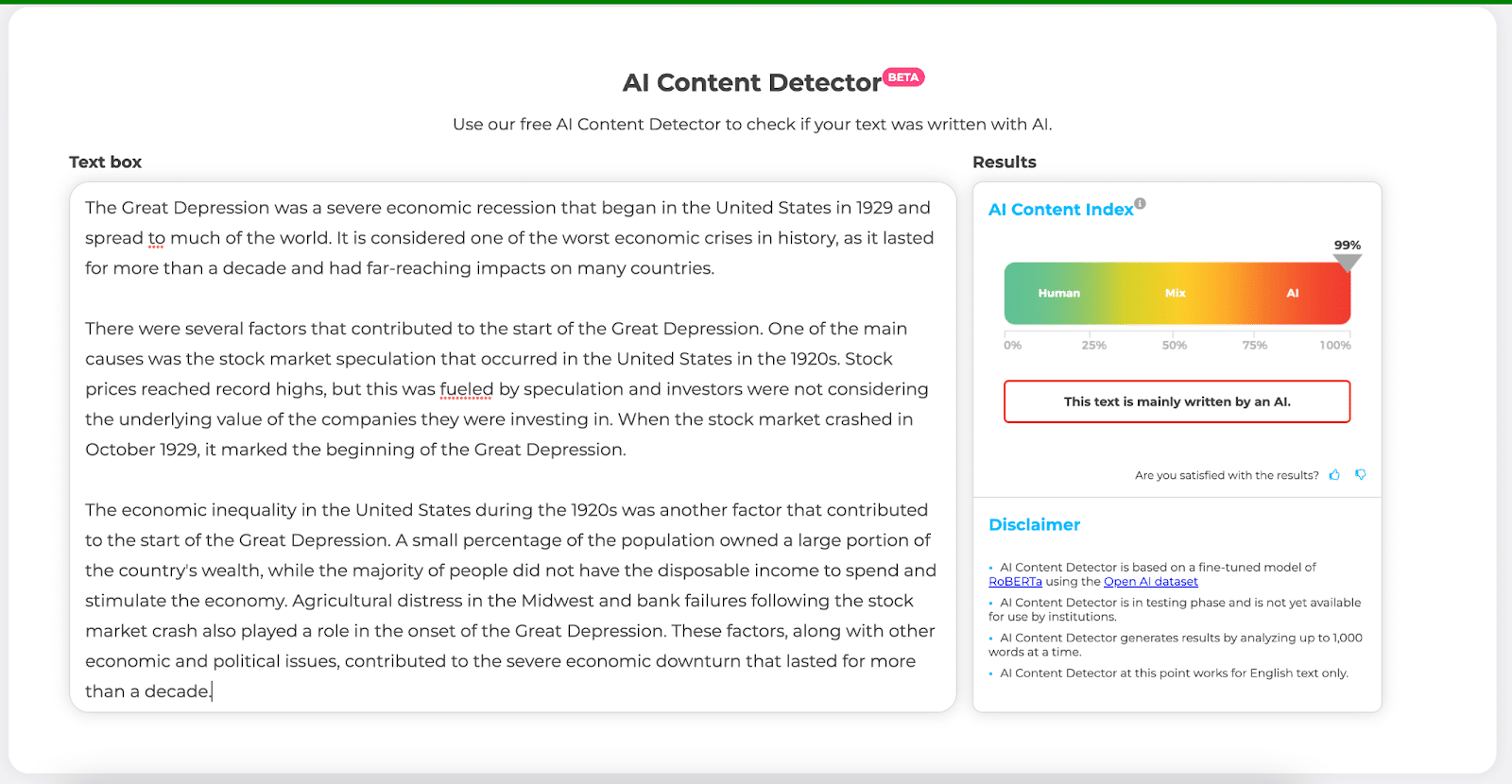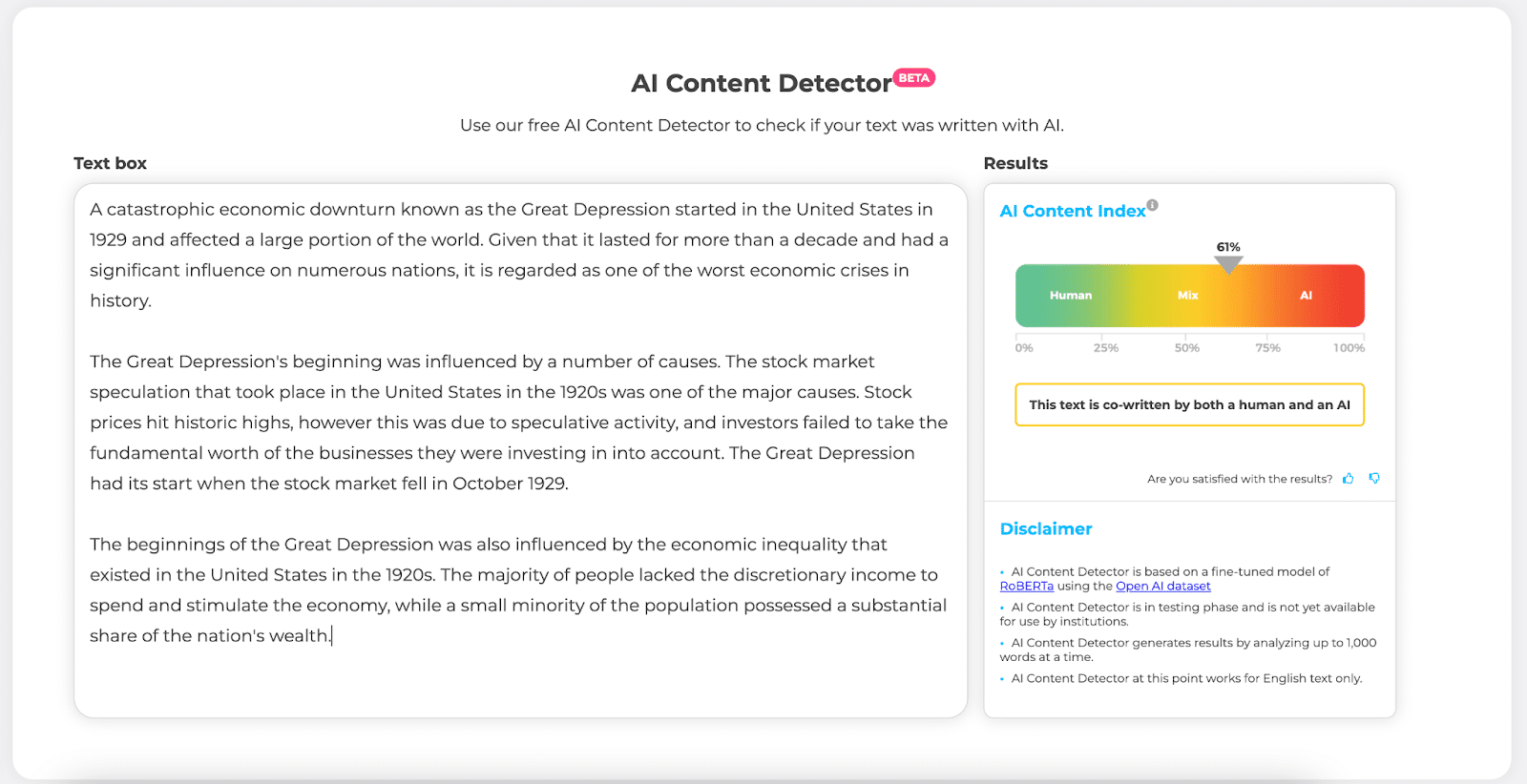“Aigiarism” is a new trend that has conquered the internet, a term none of us have heard before.
Aigiarism refers to plagiarism using artificial intelligence to generate content and do the work for you. Most likely. In the past two weeks, you must have heard so much about ChatGPT and all the fantastic things you can do with it. However, ChatGPT started having immediate negative implications in the academic world as it proved successful in helping students generate content without doing any work.
ChatGPT was created by OpenAI and is arguably the most discussed application of the moment. Still, there is (or at least will be soon) a considerable downside – originality.
Is AI going to be the Achilles’ heel of academic integrity?
The difficulty in determining whether ChatGPT or the student created the essay creates a challenge for professors. To find this out, they would need a tool that is easy to use and efficient.
Introducing our AI content detector
Now that AI-generated content has become a sensation, unfortunately, students have taken a toll on it as ChatGPT can write constructive essays that are nearly impossible to detect by the human eye alone. Indeed, this has been a massive concern for the academic world as originality and academic integrity could face a new possible threat.
Everything that is newly introduced and seems hard to counter will eventually find a proper solution to neutralize it. And aigiarism is no exception.
Using the logic of “if you can’t make them stop using it, at least you can expose them,” we introduced the AI Content Detector to shine the light on the content generated using AI.
Practical, easy-to-use, and precise results make our AI Content Detector worthy in the fight against aigiarism.
We are offering our AI Content Detector for free for all of our individual users during our Beta phase to test and evaluate the results it generates.
AI Content Detector in the education field
Let’s suppose a scenario where a professor assigns a student to write an essay on “How did the ‘Great Depression’ start,” and the student decides to ask an AI-content-driven tool to generate some content from it.
In our study case, we’ll ask ChatGPT. Here’s what it returned to us:
“The Great Depression was a severe economic recession that began in the United States in 1929 and spread to much of the world. It is considered one of the worst financial crises in history. It lasted for more than a decade and had far-reaching impacts on many countries.
Several factors contributed to the start of the Great Depression. One of the leading causes was the stock market speculation that occurred in the United States in the 1920s. Stock prices reached record highs, but this was fueled by belief, and investors were not considering the underlying value of the companies they were investing in. When the stock market crashed in October 1929, it marked the beginning of the Great Depression.
The economic inequality in the United States during the 1920s was another factor that contributed to the start of the Great Depression. A small percentage of the population owned a large portion of the country’s wealth. At the same time, most people did not have the disposable income to spend and stimulate the economy. Agricultural distress in the Midwest and bank failures following the stock market crash also influenced the onset of the Great Depression. These factors and other economic and political issues contributed to the severe economic downturn that lasted for more than a decade.”
On the surface, it is a well-written, to-the-point, and perfectly possible one that a human wrote. But let’s test it out in our AI Content Detector.

As expected, our AI Content Detector tells us that it’s 99% likely that an AI wrote this.
Even if we were to modify and customize it to clear the traces, our tool would likely still find the paths of the AI-generated content. It will show you the arrow somewhere in the middle where the “Mix” section is:

You can try it out yourself, too.
How do I start?
Since it’s nearly impossible to know if a piece of text is human-written or rather AI-generated without the help of an external source, the AI Content Detector is probably the best solution for this phenomenon.
And to top it off, it’s easy to use and all for free. Here’s what’s required from you
- Create an account
- Paste the text
- See the results
To use it, you’ll first have to create an account at Crossplag. Besides the AI Content Detector, you will also enjoy all the benefits that come with it – 10 free credits to check for single-language plagiarism and translation plagiarism.
Next, on the top leftmost of the menu, you’ll find the AI Content Detector where upon clicking, you’ll be presented with a text area where you can input the copied text. On a side note, currently, the tool only works for the English language. We don’t support any other language, so if you paste a text from another language, you’ll most likely get the response that it’s human-written.
The results from the pasted text will be present at the top right of the page in a few seconds. The first thing you’ll probably notice is a new word name AI Content Index. To explain this in bold lines, the AI Content Index ranges from 0 to 100, displaying the probability of the text being written by AI in percentage – the higher the number, the more likely it is that an AI wrote it.

What does the result mean?
Now that we have pasted the text, and we got a result – but it might be confusing as, to keep in mind, this is all new and could be too much to digest.
First of all, in the result section of the results, we have a bar and some text beneath, which is there to let you know what our guess is that AI wrote the text. The bar goes from ‘Human’ to ‘Mix’ to ‘AI.’
These are the three real possibilities which the text was generated from. Here’s what our tool wants to tell you about each of these options:
Human – A human most likely writes the text without an AI’s help. The text is genuine and could be interpreted as the original in terms of authorship.
Mix – The text is most likely a mix between human writing and AI-generated. This can occur when the text was initially generated by an AI but then modified and customized by a human.
AI – The text is most likely written by an AI, no matter how human it seems at first glance.
The AI Content Detector is based on a fine-tuned model of RoBERTa using the Open AI dataset and uses state-of-the-art machine learning to detect human patterns and irregularities in a text. Another characteristic that is a clear indicator is the repetitive language and the inconsistency of the tone.
An advantage of our AI Content Detector is that it is a product of Crossplag – a plagiarism detector – and, more often than not, the AI generates text from existing sources.
More sources on AI Content Detector
– Information on our AI Content Detector

Agnesa is crazy about math and has won lots of prizes. Although her main gig is being a full-stack developer, she also likes to write about topics she knows really well.
But, Agnesa isn’t just about numbers and algorithms.
When she’s not crunching code or weaving words, you’ll find her conquering mountains with her trusty hiking boots!

